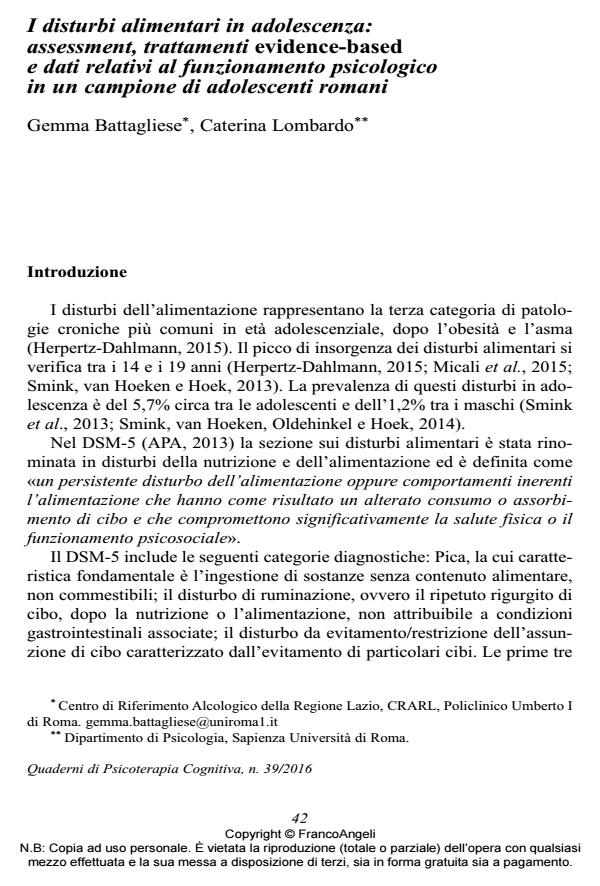Eating Disorders in adolescence: assessment, evidence based treatment and data regarding psychological functioning in a sample of roman adolescents
Journal title QUADERNI DI PSICOTERAPIA COGNITIVA
Author/s Gemma Battagliese, Caterina Lombardo
Publishing Year 2016 Issue 2016/39
Language Italian Pages 27 P. 42-68 File size 174 KB
DOI 10.3280/QPC2016-039004
DOI is like a bar code for intellectual property: to have more infomation
click here
Below, you can see the article first page
If you want to buy this article in PDF format, you can do it, following the instructions to buy download credits

FrancoAngeli is member of Publishers International Linking Association, Inc (PILA), a not-for-profit association which run the CrossRef service enabling links to and from online scholarly content.
Eating disorders are among the most relevant disorders in adolescence, being often chronic and associated to medical and psychiatric comorbidities. Evidence based treatment suggested in eating disorders are: the Family-Based Treatment, indicated as gold standard for Anorexia Nervosa, Adolescent-Focused Therapy and CBT-E that include within the treatment protocol the work on psychological aspects interfering with the treatment as perfectionism, low self-esteem and interpersonal problems. Aims of the present paper are: to review scientific progress on diagnostic criteria, etiology, assessment and evidence-based treatment of eating disorders in adolescence and to provide data regarding dysfunctional eating behaviors and related psychological functioning in a sample of adolescents aged 14-19 recruited in Rome.Results of the study show that 4% (6.4% female; 1% male) of the adolescents reported scores in the relevant clinical range suggesting high probability that an eating disorder is present. High scores of eating disorder symptoms were negatively associated to self-esteem; positively related to personal and interpersonal problems, emotional dysregulation, perception of inadequacy, and psychological distress. Only in female, high symptomatology were positively associated with perfectionism and hyper-control. It is important, therefore, that clinicians working with this spectrum of disorders in adolescence conduct an adequate evaluation and propose treatments evidence-based taking also into account the psychological functioning associated with the disorder.
Keywords: Anorexia nervosa, bulimia nervosa, Binge Eating Disorder, adolescence, evidence- based treatment.
Gemma Battagliese, Caterina Lombardo, I disturbi alimentari in adolescenza: assessment, trattamenti evidence-based e dati relativi al funzionamento psicologico in un campione di adolescenti romani in "QUADERNI DI PSICOTERAPIA COGNITIVA" 39/2016, pp 42-68, DOI: 10.3280/QPC2016-039004